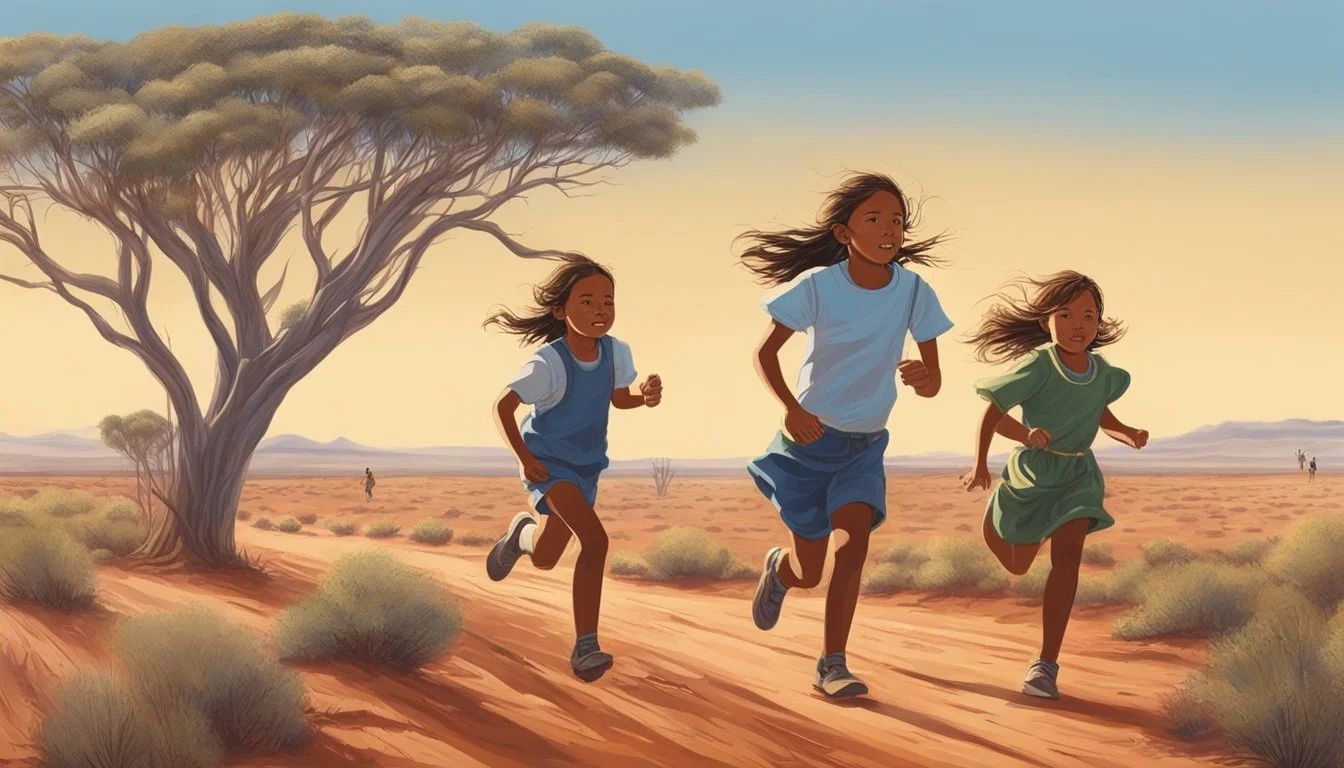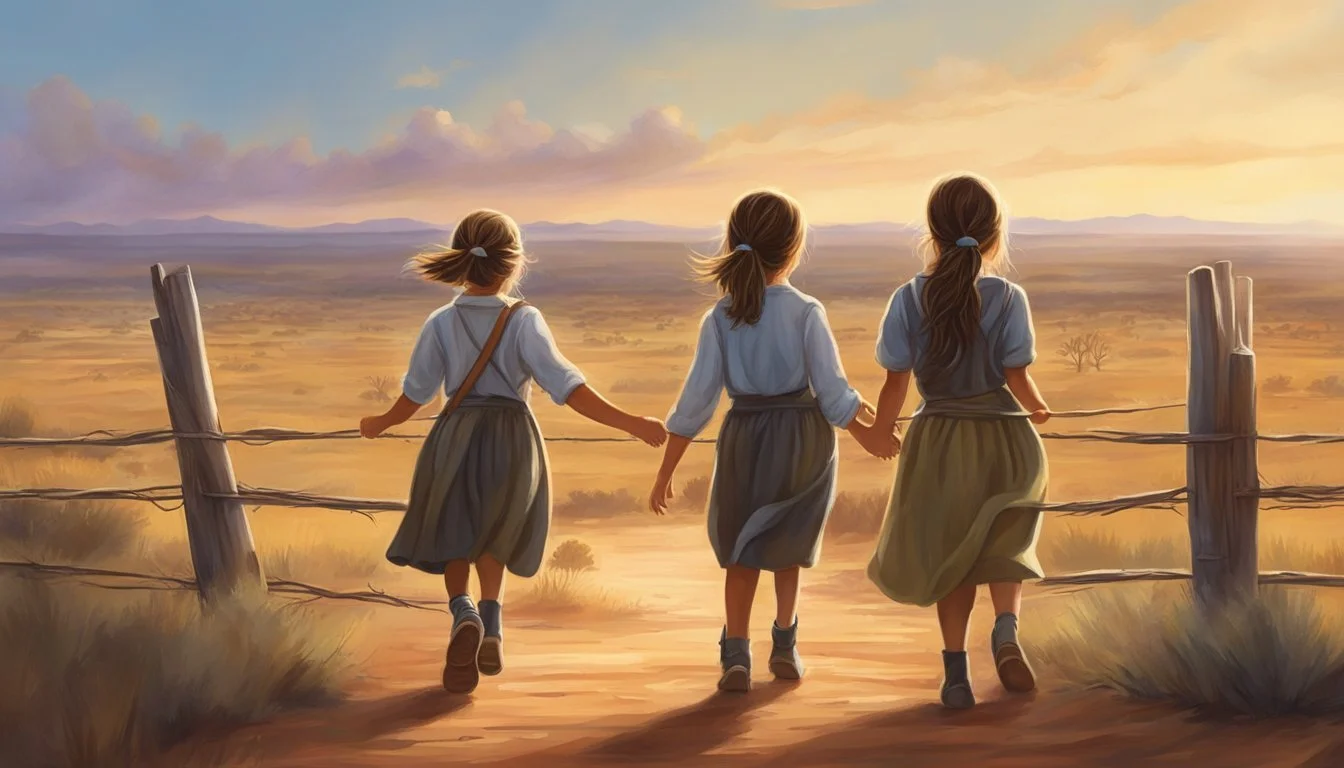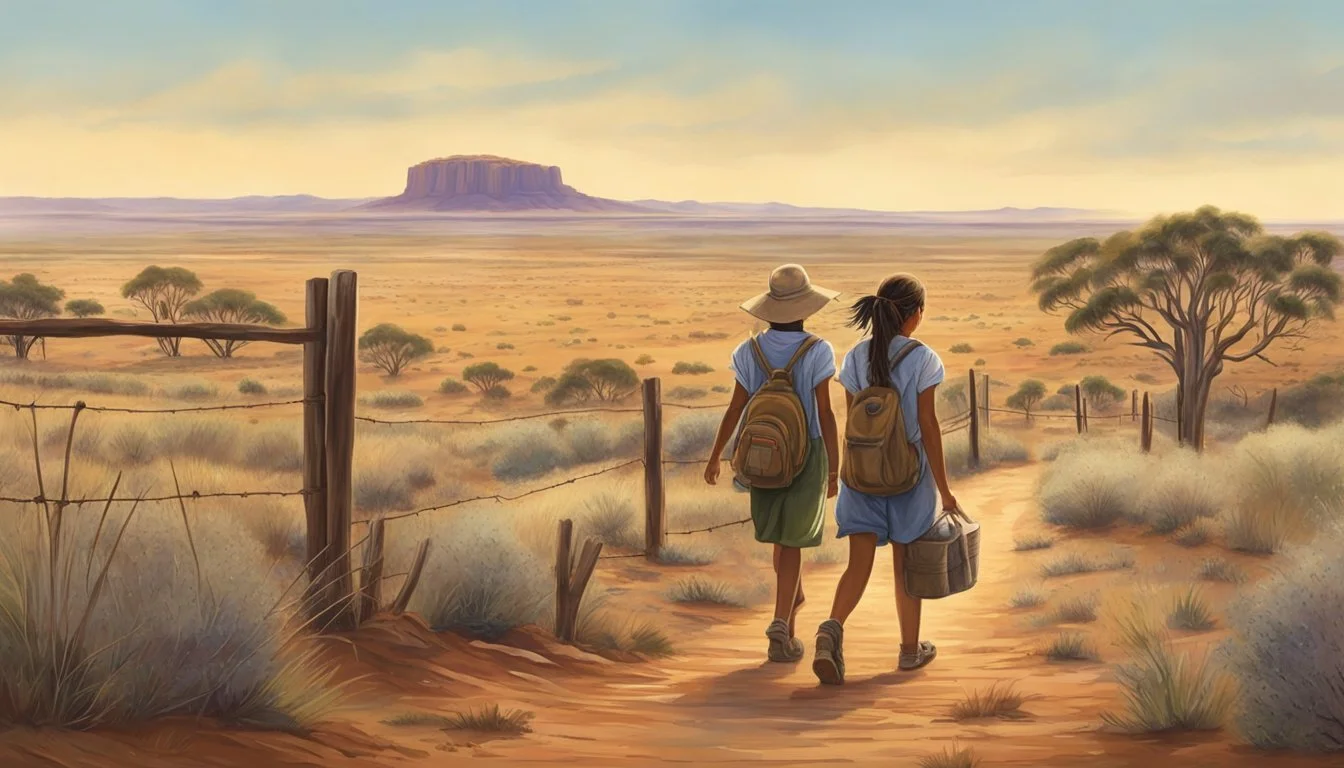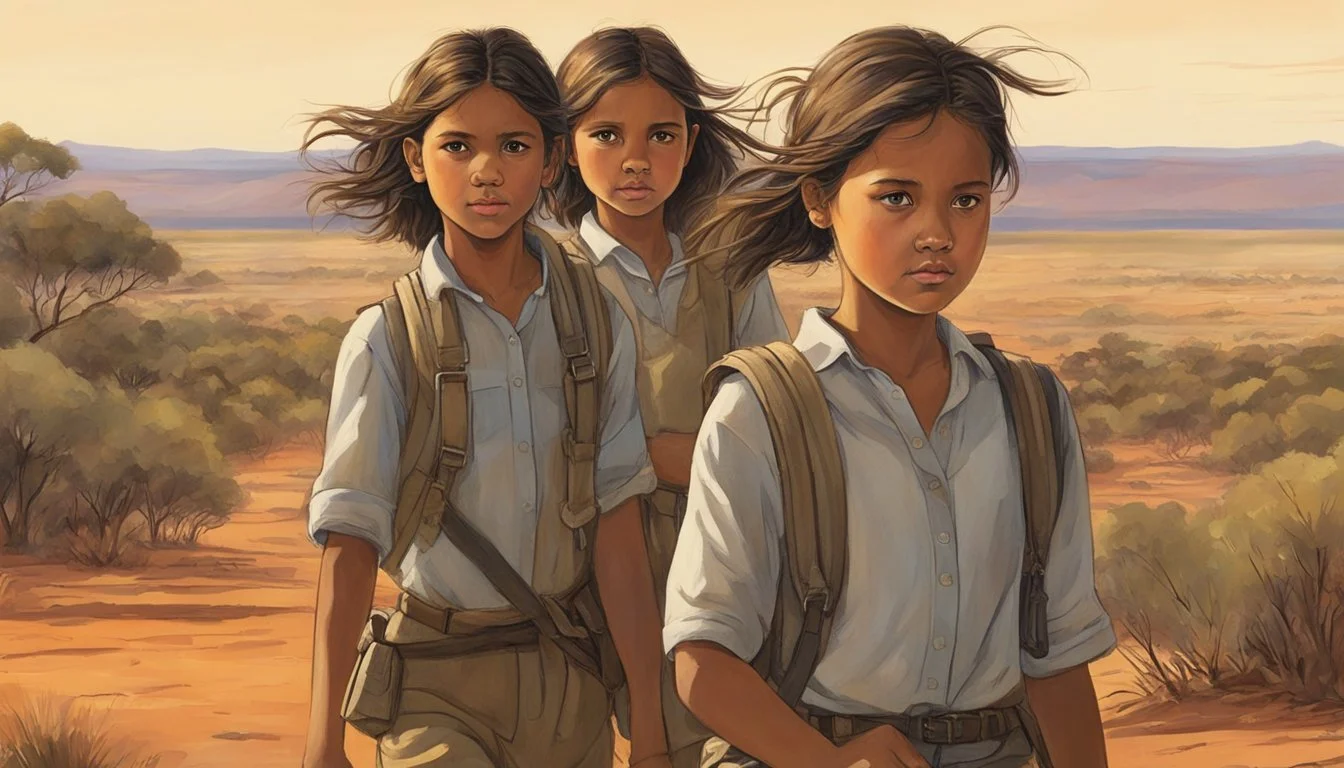Escaping Assimilation: The True Journey Along the Rabbit-Proof Fence
Indigenous Girls' Epic Trek Across Australia
In 1931, three young Aboriginal girls embarked on a remarkable journey across the Australian outback, defying the government's forced assimilation policies. Molly, Daisy, and Gracie, aged 14, 11, and 8 respectively, were taken from their families and placed in the Moore River Native Settlement as part of Australia's "Stolen Generations" program. Their daring escape and subsequent 1,500-mile trek home along the rabbit-proof fence became a powerful symbol of resistance against oppressive government policies.
The girls' incredible story inspired Doris Pilkington's book "Follow the Rabbit-Proof Fence" and the subsequent 2002 film "Rabbit-Proof Fence." These works brought international attention to the plight of Aboriginal children forcibly removed from their families. The rabbit-proof fence, originally built to keep rabbits out of farming areas, served as a lifeline for the girls, guiding them through harsh terrain back to their community in Jigalong.
This true story of courage and determination highlights the resilience of Aboriginal people in the face of systemic discrimination. It sheds light on a dark chapter in Australian history and continues to resonate with audiences worldwide, prompting discussions about cultural identity, family bonds, and the long-lasting impacts of government policies on Indigenous communities.
Historical Context
The "Rabbit-Proof Fence" story unfolded against a backdrop of discriminatory government policies targeting Indigenous Australians. These policies aimed to assimilate Aboriginal children into white society, leading to widespread forced removals and cultural suppression.
Stolen Generations
The Stolen Generations refers to Aboriginal and Torres Strait Islander children forcibly removed from their families by Australian government agencies and church missions. This practice began in the early 1900s and continued until the 1970s.
Children of mixed Aboriginal and European descent were primary targets. Government officials believed these children could be more easily assimilated into white society.
The removals caused immense trauma to Indigenous families and communities. Many children lost their cultural identity, language, and connection to their heritage.
Government Policies
The Australian government implemented policies of "protection" and assimilation towards Indigenous people. These policies granted extensive powers to government officials over Aboriginal lives.
The Chief Protector of Aborigines held legal guardianship over Indigenous children. This role allowed for the removal of children without parental consent.
The 1905 Aborigines Act in Western Australia exemplified these policies. It restricted Aboriginal movement, employment, and marriages.
Indigenous Australian Resistance
Despite oppressive policies, Indigenous Australians actively resisted attempts to erase their culture and identity. Many families hid their children to prevent removal.
Some, like Molly, Daisy, and Gracie from the "Rabbit-Proof Fence" story, escaped from institutions and embarked on long journeys to return home.
Indigenous activists campaigned tirelessly for recognition and rights. Their efforts contributed to policy changes and increased awareness of the Stolen Generations' experiences.
The True Journey of Molly Craig
Molly Craig's remarkable escape from forced assimilation and her incredible 1,600 kilometer trek across the Australian outback is a testament to human resilience and determination. Her story sheds light on the plight of Indigenous children during Australia's Stolen Generations period.
Molly's Early Life
Molly Craig was born in 1917 in Jigalong, a remote Aboriginal community in Western Australia. She belonged to the Martu people and lived a semi-nomadic life with her family along the rabbit-proof fence. This massive structure, stretching over 2,000 miles, was built to keep rabbits out of farmlands.
Molly's childhood was abruptly interrupted in 1931 when she was forcibly removed from her home. At just 14 years old, she was taken to the Moore River Native Settlement along with her younger sister Daisy and cousin Gracie.
Escape from Moore River
The Moore River Native Settlement was a government institution designed to assimilate Indigenous children into white Australian society. Conditions were harsh, with strict rules and punishments.
Molly, Daisy, and Gracie found life at Moore River intolerable. They made a daring escape just weeks after arriving. Using stealth and ingenuity, the girls managed to slip away unnoticed.
Their goal was to return home to Jigalong, a journey that would require traversing 1,600 kilometers of challenging terrain.
The 1,600 Kilometer Journey
The girls' trek home was an extraordinary feat of endurance and navigation. They followed the rabbit-proof fence as a guide, knowing it would lead them back to familiar territory.
For nine weeks, they walked through harsh desert landscapes, facing numerous challenges:
Extreme temperatures
Lack of food and water
Risk of detection by authorities
Molly, as the eldest, took on a leadership role. She used skills learned from her family to find water and food in the unforgiving environment.
Despite exhaustion and hardship, the girls persevered. Their journey ended in triumph when they finally reached Jigalong and were reunited with their families.
Cultural Significance
The journey depicted in "Rabbit-Proof Fence" holds deep cultural importance for Aboriginal communities. It illuminates the resilience of Indigenous Australian culture and identity in the face of assimilation policies.
Impact on Aboriginal Communities
The story resonates strongly with Aboriginal communities across Australia. It sheds light on the shared experiences of the Stolen Generations, validating their struggles and triumphs. The narrative serves as a powerful tool for education and reconciliation.
Many Aboriginal families use the story to connect younger generations with their history. It sparks conversations about cultural heritage and the importance of maintaining traditional ties.
The film adaptation brought wider attention to these issues, fostering greater understanding among non-Indigenous Australians.
Role of Language and Identity
Language plays a crucial role in the cultural significance of "Rabbit-Proof Fence". The girls' use of their native Mardu language throughout their journey symbolizes their connection to their roots.
This emphasis on language highlights its importance in preserving Aboriginal identity. It demonstrates how Indigenous languages serve as carriers of culture, knowledge, and worldviews.
The story underscores the resilience of Aboriginal languages despite historical attempts to suppress them. It has inspired efforts to revitalize and maintain Indigenous languages across Australia.
Survival and Resilience
"Rabbit-Proof Fence" exemplifies the extraordinary resilience of Aboriginal people. The girls' 1,500-mile journey on foot showcases their survival skills and determination.
Their ability to navigate using traditional knowledge emphasizes the value of Indigenous wisdom. This aspect of the story has encouraged a renewed appreciation for Aboriginal survival techniques and connection to the land.
The narrative challenges stereotypes about Indigenous Australians, presenting them as resourceful and tenacious. It has become a source of pride and inspiration for many Aboriginal communities.
The story's enduring popularity reflects its power to celebrate Aboriginal strength in the face of adversity.
Literature and Film
The story of the three Aboriginal girls' escape along the rabbit-proof fence captivated audiences through both literature and film. Their journey became a powerful narrative of resistance against forced assimilation policies.
Doris Pilkington's Authorship
Doris Pilkington, also known as Nugi Garimara, wrote "Follow the Rabbit-Proof Fence" in 1996. The book recounts the true story of her mother Molly Craig's 1,500-mile trek home with two other girls in 1931. Pilkington based her work on oral histories from her family and archival research.
The author's personal connection to the events lends authenticity to the narrative. Pilkington's work brought wider attention to the Stolen Generations - Indigenous children forcibly removed from their families by the Australian government.
Adaptation into Film
In 2002, director Phillip Noyce adapted Pilkington's book into the film "Rabbit-Proof Fence". Screenwriter Christine Olsen worked closely with Pilkington to craft the screenplay. The film stars Aboriginal actresses Everlyn Sampi, Tianna Sansbury, and Laura Monaghan as Molly, Daisy, and Gracie.
Noyce's direction emphasizes the harsh landscape and emotional journey of the girls. The film uses minimal dialogue, relying on evocative visuals and music to convey the story's power.
Global Reception
Both the book and film received critical acclaim internationally. "Follow the Rabbit-Proof Fence" has been translated into several languages, spreading awareness of this chapter in Australian history.
The film "Rabbit-Proof Fence" won multiple awards, including Best Film at the Australian Film Institute Awards. It sparked important conversations about historical injustices against Indigenous peoples.
The story's global reach has made it a significant work in postcolonial literature and cinema. It continues to be studied in schools and universities as a poignant example of resilience in the face of systemic oppression.
Character Profiles
The three young protagonists of Follow the Rabbit-Proof Fence each possess unique traits that shape their harrowing journey. Their individual characteristics and experiences highlight different aspects of the Stolen Generations' struggle.
Molly's Leadership
Molly Craig, the eldest at 14, emerges as the natural leader of the group. Her determination and resourcefulness drive the girls' escape and 1,500-mile trek home. Molly's knowledge of the bush, passed down from her Aboriginal family, proves crucial to their survival.
She demonstrates quick thinking and adaptability in evading capture. Molly's strength lies in her unwavering focus on their goal, even in the face of harsh conditions and setbacks.
Her leadership inspires confidence in her younger companions. Molly's character embodies the resilience and cultural connection of Indigenous youth forcibly removed from their families.
Daisy's Innocence
At just 8 years old, Daisy Kadibil represents the vulnerability of the youngest children affected by the assimilation policies. Her trust in Molly's guidance highlights the bonds formed between the girls during their shared ordeal.
Daisy's innocence is juxtaposed with her growing bravery as the journey progresses. She learns to overcome her fears, even chasing away a potential threat by throwing rocks.
Her curiosity leads her to ask many questions, allowing readers to understand the girls' experiences through a child's perspective. Daisy's character emphasizes the impact of forced separation on young, impressionable minds.
Gracie's Conflict
Gracie, 11 years old, occupies a middle ground between Molly's leadership and Daisy's innocence. Her character highlights the internal struggles faced by many Stolen Generations children.
Gracie's desire to reunite with her mother in Wiluna creates tension within the group. This conflict showcases the complex emotions and divided loyalties experienced by those torn from their families.
Her eventual decision to leave the group in search of her mother adds a layer of tragedy to the story. Gracie's character serves as a poignant reminder of the lasting impact of family separation on Indigenous communities.
Survival Techniques and Challenges
The journey along the rabbit-proof fence demanded extraordinary survival skills and presented numerous obstacles. The three young girls faced harsh desert conditions and constant pursuit as they navigated their way home.
Skills for Survival
Molly, Gracie, and Daisy relied on their traditional knowledge to survive the arduous trek. They foraged for bush tucker, identifying edible plants and small animals. Water procurement was crucial in the arid environment. The girls dug soakages in dry riverbeds to access underground water.
Navigation skills proved essential. They used the rabbit-proof fence as their guide, following its path northward. The girls traveled at night to avoid detection and rested during the hot days.
Their ability to move silently and leave minimal traces helped them evade capture. They used natural materials for shelter, constructing temporary windbreaks from branches and leaves.
Encounters and Challenges
The harsh desert landscape posed significant risks. Extreme temperatures, lack of water, and dangerous wildlife threatened their survival. Poisonous snakes and scorpions were constant dangers.
Hunger and thirst were persistent challenges. The girls often went days with little food or water. Physical exhaustion tested their resolve as they covered vast distances on foot.
Encounters with settlers and police posed risks of recapture. The girls had to remain vigilant and hide when vehicles or strangers approached. They used their knowledge of the land to find concealment in the sparse vegetation.
Crossing open plains left them exposed. They timed these crossings carefully, using darkness for cover. Rivers and rough terrain slowed their progress, requiring ingenuity to overcome.
Legacy and Reflections
The journey of Molly, Gracie, and Daisy along the rabbit-proof fence left an indelible mark on Australian history. Their story continues to resonate, shedding light on the Stolen Generations and inspiring reflection on past policies.
Molly's Later Life
Molly Craig's life after her escape was marked by resilience and determination. She returned to her homeland in Jigalong, where she raised a family and maintained her cultural connections. Despite facing ongoing challenges, Molly preserved her indigenous identity and traditions.
In later years, Molly shared her experiences with her daughter, Doris Pilkington. This act of storytelling became crucial in bringing the plight of the Stolen Generations to wider attention.
Continued Significance
The story of the rabbit-proof fence escape remains a powerful symbol of resistance against forced assimilation. It has been adapted into various media, including Pilkington's book and a critically acclaimed film.
These retellings have:
Raised awareness about the Stolen Generations
Sparked discussions on indigenous rights
Influenced public opinion on reconciliation efforts
The narrative continues to be taught in schools, ensuring new generations understand this chapter of Australian history.
Learning from History
The journey along the rabbit-proof fence prompts crucial reflections on past government policies. It highlights the lasting impact of the forced removal of Aboriginal children from their families and communities.
Key lessons include:
The importance of preserving indigenous cultures
The need for acknowledging historical injustices
The value of listening to and amplifying indigenous voices
These insights have influenced policy changes and contributed to formal apologies from the Australian government. The story serves as a reminder of the ongoing need for reconciliation and respect for indigenous rights and cultures.





